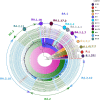Omicron BA.2 lineage predominance in severe acute respiratory syndrome coronavirus 2 positive cases during the third wave in North India
- PMID: 36405589
- PMCID: PMC9666497
- DOI: 10.3389/fmed.2022.955930
Omicron BA.2 lineage predominance in severe acute respiratory syndrome coronavirus 2 positive cases during the third wave in North India
Abstract
Background: Recent studies on severe acute respiratory syndrome coronavirus 2 (SARS-CoV-2) reveal that Omicron variant BA.1 and sub-lineages have revived the concern over resistance to antiviral drugs and vaccine-induced immunity. The present study aims to analyze the clinical profile and genome characterization of the SARS-CoV-2 variant in eastern Uttar Pradesh (UP), North India.
Methods: Whole-genome sequencing (WGS) was conducted for 146 SARS-CoV-2 samples obtained from individuals who tested coronavirus disease 2019 (COVID-19) positive between the period of 1 January 2022 and 24 February 2022, from three districts of eastern UP. The details regarding clinical and hospitalized status were captured through telephonic interviews after obtaining verbal informed consent. A maximum-likelihood phylogenetic tree was created for evolutionary analysis using MEGA7.
Results: The mean age of study participants was 33.9 ± 13.1 years, with 73.5% accounting for male patients. Of the 98 cases contacted by telephone, 30 (30.6%) had a travel history (domestic/international), 16 (16.3%) reported having been infected with COVID-19 in past, 79 (80.6%) had symptoms, and seven had at least one comorbidity. Most of the sequences belonged to the Omicron variant, with BA.1 (6.2%), BA.1.1 (2.7%), BA.1.1.1 (0.7%), BA.1.1.7 (5.5%), BA.1.17.2 (0.7%), BA.1.18 (0.7%), BA.2 (30.8%), BA.2.10 (50.7%), BA.2.12 (0.7%), and B.1.617.2 (1.3%) lineages. BA.1 and BA.1.1 strains possess signature spike mutations S:A67V, S:T95I, S:R346K, S:S371L, S:G446S, S:G496S, S:T547K, S:N856K, and S:L981F, and BA.2 contains S:V213G, S:T376A, and S:D405N. Notably, ins214EPE (S1- N-Terminal domain) mutation was found in a significant number of Omicron BA.1 and sub-lineages. The overall Omicron BA.2 lineage was observed in 79.5% of women and 83.2% of men.
Conclusion: The current study showed a predominance of the Omicron BA.2 variant outcompeting the BA.1 over a period in eastern UP. Most of the cases had a breakthrough infection following the recommended two doses of vaccine with four in five cases being symptomatic. There is a need to further explore the immune evasion properties of the Omicron variant.
Keywords: COVID-19; SARS-CoV-2; omicron; third wave; variant of concern (VOC); whole-genome sequencing (WGS).
Copyright © 2022 Zaman, Shete, Mishra, Kumar, Reddy, Sahay, Yadav, Majumdar, Pandey, Dwivedi, Deval, Singh, Behera, Kumar, Patil, Kumar, Dudhmal, Joshi, Shukla, Gawande, Kavathekar, Kumar, Kumar, Kumar, Singh, Kumar, Tiwari, Verma, Yadav and Kant.
Conflict of interest statement
The authors declare that the research was conducted in the absence of any commercial or financial relationships that could be construed as a potential conflict of interest.
Figures





Similar articles
-
Structural and genomic evolutionary dynamics of Omicron variant of SARS-CoV-2 circulating in Madhya Pradesh, India.Front Med (Lausanne). 2024 Sep 11;11:1416006. doi: 10.3389/fmed.2024.1416006. eCollection 2024. Front Med (Lausanne). 2024. PMID: 39323472 Free PMC article.
-
Mutational characterization of Omicron SARS-CoV-2 lineages circulating in Chhattisgarh, a central state of India.Front Med (Lausanne). 2023 Jan 23;9:1082846. doi: 10.3389/fmed.2022.1082846. eCollection 2022. Front Med (Lausanne). 2023. PMID: 36755883 Free PMC article.
-
Low SARS-CoV-2 viral load among vaccinated individuals infected with Delta B.1.617.2 and Omicron BA.1.1.529 but not with Omicron BA.1.1 and BA.2 variants.Front Public Health. 2022 Sep 20;10:1018399. doi: 10.3389/fpubh.2022.1018399. eCollection 2022. Front Public Health. 2022. PMID: 36211690 Free PMC article.
-
SARS-CoV-2 Omicron variants: burden of disease, impact on vaccine effectiveness and need for variant-adapted vaccines.Front Immunol. 2023 May 23;14:1130539. doi: 10.3389/fimmu.2023.1130539. eCollection 2023. Front Immunol. 2023. PMID: 37287979 Free PMC article. Review.
-
Omicron BA.2 Lineage, the "Stealth" Variant: Is It Truly a Silent Epidemic? A Literature Review.Int J Mol Sci. 2022 Jun 30;23(13):7315. doi: 10.3390/ijms23137315. Int J Mol Sci. 2022. PMID: 35806320 Free PMC article. Review.
Cited by
-
Therapeutic Potential of Neutralizing Monoclonal Antibodies (nMAbs) against SARS-CoV-2 Omicron Variant.Curr Pharm Des. 2025;31(10):753-773. doi: 10.2174/0113816128334441241108050528. Curr Pharm Des. 2025. PMID: 39543801 Review.
-
Genomic Insights Into the Evolution and Demographic History of the SARS-CoV-2 Omicron Variant: Population Genomics Approach.JMIR Bioinform Biotechnol. 2023 Jun 12;4:e40673. doi: 10.2196/40673. eCollection 2023. JMIR Bioinform Biotechnol. 2023. PMID: 37456139 Free PMC article.
-
Genetic diversity and evolutionary patterns of SARS-CoV-2 among the Bhutanese population during the pandemic.Osong Public Health Res Perspect. 2023 Dec;14(6):494-507. doi: 10.24171/j.phrp.2023.0209. Epub 2023 Dec 14. Osong Public Health Res Perspect. 2023. PMID: 38204428 Free PMC article.
-
BA.1, BA.2 and BA.2.75 variants show comparable replication kinetics, reduced impact on epithelial barrier and elicit cross-neutralizing antibodies.PLoS Pathog. 2023 Feb 24;19(2):e1011196. doi: 10.1371/journal.ppat.1011196. eCollection 2023 Feb. PLoS Pathog. 2023. PMID: 36827451 Free PMC article.
-
Newer emerging SARS-COV2 variant: Omicron EG.5.Ann Med Surg (Lond). 2023 Oct 4;85(12):5845-5846. doi: 10.1097/MS9.0000000000001386. eCollection 2023 Dec. Ann Med Surg (Lond). 2023. PMID: 38098560 Free PMC article. No abstract available.
References
-
- WHO. Coronavirus (COVID-19) Dashboard. Geneva: World Health Organization; (2022).
-
- MoHFW. COVID-19 Statewise Status. New Delhi: Ministry of Health and Family Welfare, Government of India; (2022).
LinkOut - more resources
Full Text Sources
Miscellaneous

